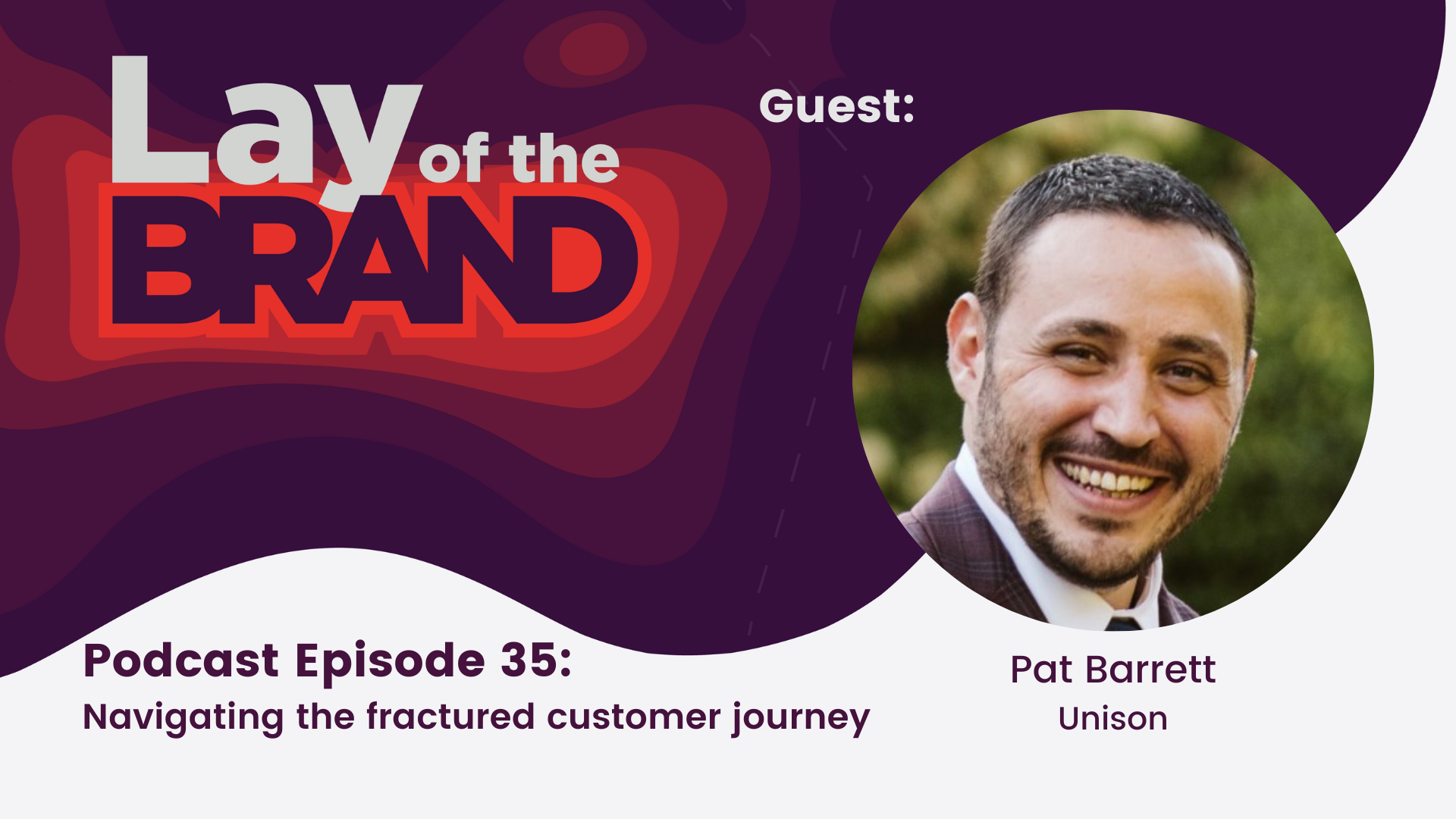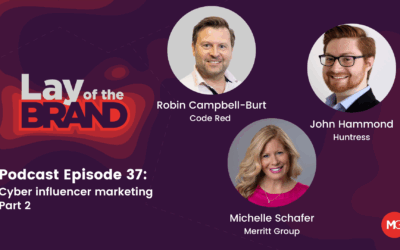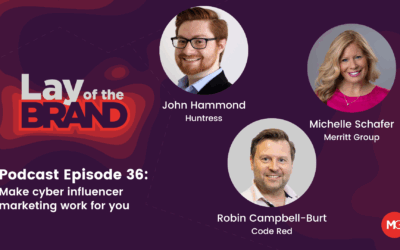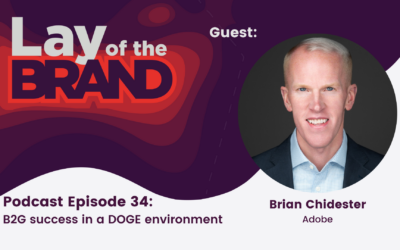Today’s buyers jump around throughout the decision process, loop in new stakeholders midstream, and often do months of research before ever speaking to sales. So why are so many marketing strategies still built around a linear sales funnel?
That’s why we’re talking with Unison’s Pat Barrett to unpack the messy reality of the modern buyer journey and uncover how you can navigate the new, fractured customer journey.
“Just because someone’s quiet with us doesn’t mean that they’re necessarily quiet. They may just be doing things on their own, and it’s important that we continue to align with that mentality.”
— Pat Barrett, Head of Marketing, Unison
About our guest: As Head of Marketing for Unison, Pat Barrett brings over 15 years of experience in marketing, brand transformation, and revenue acceleration. He specializes in developing data-driven marketing strategies, optimizing demand generation, and scaling brands to industry leadership.
Episode transcript (edited for clarity):
Peter Jacobs, Lay of the Brand:
Welcome to Lay of the Brand, where we talk with the experts on tech, marketing, creative and PR to learn what’s new, what’s working and what’s next. I’m Peter Jacobs with Merritt Group. The customer journey was never really a straight line, but now that familiar funnel is completely fractured, and whether it’s B to B or B to G, the more complex the sale, the more convoluted the journey. Today’s buyers jump around throughout the decision process, loop in new stakeholders midstream, and often do months of research before ever speaking to sales. So why are so many marketing strategies still built around a linear funnel? That’s why we’re talking with Pat Barrett, Head of Marketing for federal business process enabler, Unison. We’ll unpack the messy reality of the modern buyer journey and uncover how you can build trust, stay relevant, and make sure you’re solving customer problems at every step when you don’t control the path. Pat. Thanks for being here.
Pat Barrett, Unison:
Thanks for having me.
Peter Jacobs:
Let’s start with a big picture. What are the biggest misconceptions marketers still have about the buyer’s journey, especially in a long, complex enterprise or government sales cycle?
Pat Barrett:
Yeah, I think you started with it, but it’s not linear, right? It’s chaotic, fragmented. There’s forward and backwards motion that you know it’s difficult to predict. I also think that there’s a still a belief in a shift from marketing to sales. You know, there’s really not a handoff, I would say anymore. It’s a combined effort through through the whole process, and then the idea that marketing can somehow push someone through this imaginary funnel, especially in enterprise software sales, that just does not add up with the world that we live in.
Peter Jacobs:
Yeah, the sales cycles are so long. I mean, we know in government, the sales cycle, we’re talking about 18 months to two years. But even in large corporate, sales cycles, it’s not just “Yeah, fine, here, here’s a credit card or here’s a purchase order.” There’s all kinds of of obstacles and committees and approvals that have to be, that have to be dealt with and gone through. So the idea that somebody is just going to follow a straight line from awareness to, “hey, tell me more” to, “okay, let’s talk brass tacks here and sign something”… It’s just not realistic.
Pat Barrett:
Not at all, you know, I think it’s, it’s interesting, because, you know, I think some people can think, “Oh, now the the prospect is running the show,” and in my mind, the goal is to make them feel like they’re running the show. But, you know, there’s marketing sign posts along the way, I would say, similar to, like, a GPS, right? Like you put in the destination, the GPS spits out the route. Like, sure, you’re in the driver’s seat, but are you actually running the show? And I like to kind of envision marketing as having those touch points and well placed marketing content along the way, where they think they’re driving, they’re in the driver’s seat, but are they really making all the decisions on their own?
Peter Jacobs:
That’s a really interesting way of putting it. I would imagine that a lot of folks who are starting to research and learn about a new technology that might be applicable to their business operations would feel like, “well, I know how to research stuff, because it’s how I buy stuff for myself personally. So I go online, I check Reddit, I check with my peers, and find out, hey, what have you done about this?” And that I believe, is where the whole linear process just totally falls apart.
Pat Barrett:
Yeah, exactly. I think people definitely carry over their personal consumer behaviors into their complex work journeys as well. And to think that marketing shouldn’t try to align with those or do something different, just just doesn’t add up to reality.
Peter Jacobs:
Say you’ve started speaking with a potential buyer, so you’re at you’re just past the awareness that you’ve gotten into the inbound lead stage of things. What happens when you stop hearing from them, or they start making decisions that jump them further down the line than they may actually be ready for? You know, because you as a marketer, as a salesperson, your job is to make sure that they’re going to get the thing that they need at the time that they need it. But maybe they’ve jumped ahead in the process, or maybe it’s just stalled. So how do you then retain trust and build more trust and stay relevant to them?
Pat Barrett:
Yeah, I think it’s consistently being useful, whether they’re their assignments on the other end or not, right? Remaining findable, remaining present. I think from the sales side, there’s, there’s a lot of hand holding and experience needed to kind of gauge where something’s headed, or what their current situation and how they’re acting, and then signals. But on the marketing side, I think it’s about consistently being present and findable. You know, just because someone’s quiet with us doesn’t mean that they’re necessarily quiet. They’re just, may just be doing things on their own, and it’s important that we continue to align with that mentality and behavior to stay top of mind, even if we’re not getting direct responses, right.
Peter Jacobs:
So what kinds of content or other tactics is most effective to reach a buyer, considering all these unpredictable touch points?
Pat Barrett:
Blogs, I found, in our world are pretty effective, mainly because the volume can be high and the specific topics can vary so widely. So if you know, everybody in every buyer has some different set of features or specifics that that they’re looking for, it could be compliance, or, you know, whatever it may be, blogs give us a nice kind of library of specific topics for those people who are doing their independent research. I think case studies are another good one. You know, less so about just reporting on stats but really describing the narrative and the pain the client would have had had they not had the product. Speaking to that. Making sure that that’s from center is important from a prospect perspective, and then third party like thought leadership articles are really valuable as well, because that lends a different type of credibility for someone who’s doing their own research. You know, if they’re they Google something or see us on a media outlet, those words resonate a bit differently than something on our self published site.
Peter Jacobs:
Right, it’s part of why so many people will ask their peers, what do you think about this situation? And then, what do you think about this product, this company? What do you have any experience with them? And having that third party credibility is crucial just to make sure that they see you as trustworthy.
Pat Barrett:
Right, and an authoritative type voice in the market, like it’s not just us talking to ourselves on our own, right?
Peter Jacobs:
What about channels? What kinds of channels are working?
Pat Barrett:
We leverage LinkedIn a lot, and especially from the paid standpoint. You know, I think as an enterprise software provider, organically on LinkedIn is an uphill battle, but targeting on LinkedIn through paid has has been successful for us. Also sponsored content on key media players in our in our ecosystem has also proven valuable. You know, I would say the kind of email drip campaign channel is not something that we rely too heavily on. Again, go going back to that, pushing someone through a funnel, we more focus on getting discovered compared to just delivering things to people directly.
Peter Jacobs:
Have you looked into influencer marketing?
Pat Barrett:
Ah, interesting. So, I think there’s, it’s an interesting time to go about that as well, especially in the federal market. I think there’s, there’s a lot of voices out there at the moment, and you know, it’s, it can be a tricky thing to do well and safely. I would say, I think sometimes there’s risk involved with that. I would say we’ve more so focused on getting good speakers for like internal events or outside kind of perspectives, or could be a panel with clients, things like that, where we’re bringing in outsiders but not relying on an influencer type personality.
Peter Jacobs:
I’m wondering what your experience has been with becoming findable through search, especially as generative AI, is starting to take over search.
Pat Barrett:
Yeah, so we, our content, has always taken the approach where we’re providing value to the audience, less about us, more about them, and I think we that has positioned us well from an AI search standpoint. You know, AI seems to not love product pages and things like that, unless you’re specifically asking, but it’s trying to give the user valid, valuable answers to the questions it’s asking, and we’ve seen a pretty decent uptick in website traffic through ai llms. So I think it’s hard to predict, never mind, year to year, day to day, what those algorithms are are focusing on and doing. But Reddit is another, you know, Google, AI seems to prioritize that a bit heavily at the moment. So we’ve dipped our toes into the water there and tried to figure out, you know, best way to engage with that community in a in a professional manner. But, you know, I found, if you are writing content about a specific topic that’s informative and informational and insightful, then we’ve performed pretty well with AI
Peter Jacobs:
Earlier, you talked about the relationship between marketing and sales, and there’s always a blurring of lines at the handoff trying to determine what is a marketing qualified lead is getting harder and harder, but we also have to deal with the fact that marketing wants credit for it, sales wants credit for it, and everyone says we’re all one big team here, right? What’s the reality when you’re dealing with a non linear process.
Pat Barrett:
Yeah, so I think that is the age old battle of marketing and sales. I’ve done my best throughout my career to not have that be the case. One thing that I’ve done consistently is a marketing qualified lead is focus on inbound. So a demo request we and if you know, we do the initial qualification, and that seems to kind of give sales less: Hey, this person’s scans came to our, you know, booth, or read our blogs or something. It’s a lot more tangible and real than more abstract general marketing leads. And also having, I have sales development on my team as well, and I found that’s a helpful bridge between marketing and sales, because he’s able to, you know, that function is able to work kind of warm engaged prospects, or, you know, warmer leads compared to inbound conversions. And then, you know, he can then work those and pass those to sales. So I think, you know, it’s a lot of transparency. You know, sales knows exactly. I meet with each of the sales teams weekly, and you know, they have a very good idea of what’s going on. Leads that have come in, stuff the SDR is working, and just alignment there.
Peter Jacobs:
Is there a loop of information so that sales lets you know what’s working or lets you know how things are progressing?
Pat Barrett:
Yeah. So we have everything integrated our marketing automation tool and our CRM so those things carry over seamlessly. So on the let’s say someone submits a demo request who marketing was engaging with that activity follows over on the CRM side, and not just history, but also new activities. So we don’t stop marketing to those people once they’re inbound. We continue that activity, and sales has full visibility into all that engagement, right in the CRM, engagement being the key word.
Peter Jacobs:
You don’t want somebody to feel like, Hey, I’ve hooked you. Now I’m going to turn you over to that person. The last thing anybody wants to feel like is, well, I’m just a number, and I’m being sold to.
Pat Barrett:
Yeah, exactly.
Peter Jacobs:
Can you give an example, good or bad, of where you tried to align with this non linear journey?
Pat Barrett:
Yeah, I think it’s, it’s a little difficult to point to a single event. I think adapting to a non linear buyer journey is really just a foundational shift in marketing strategy, you know, similar to how the modern buyer journey isn’t comprised of single moments. You know, I wouldn’t think, I don’t really have a single moment here, either. I feel like we kind of had to rewire how we think about providing relevant and accessible content that really meets people where they are. You know, that’s even if the first touch point may be a old late stage funnel asset, and the second touch point is a higher level thought leadership blog, like just making sure that we are there and whether they’re moving forwards or backwards, we’re accessible.
Peter Jacobs:
So what kind of lessons have you learned as you’ve been developing this way of doing things? I’m sure some things have worked great, and other things, “hey, maybe we’ll try that again.”
Pat Barrett:
Yeah, I think pressure on sales to be like co-architects in the process, I wish I did more of. I think there’s been tremendous value in that. So you know, they know when a buyer at, you know, ask for, you know, a certain asset or a certain question in the journey. They know when they may pull in security. They know you know, certain insights that you know I’ve found over time that I wish I pressed for upfront a bit more.
Peter Jacobs:
Are you finding that you’re creating different types of assets to meet all of these different stages?
Pat Barrett:
Yes, and I would also say we take an account approach as well, right? So, especially in enterprise software, you know, larger accounts, we do dedicate more time to if they have a specific challenge that requires a specific case study or a specific piece of collateral around security or something. We’ll take the time to do that.
Peter Jacobs:
If marketers are trying to figure this out for themselves, being something that it’s a reality, but not everybody’s dealing with it, where would they start? What should they be thinking about?
Pat Barrett:
Yeah, I think evaluating your content types and placement. Can it be found where buyers are actually looking throughout a stretch of a long period of time, right? Or is it buried behind a form or in some nurture drip campaign that maybe they’ll end up in, maybe they won’t, or can they autonomously come across the assets you want them to, you know, I mentioned being built for discovery, you know, and really making sure that content is valuable and usable across a spectrum of time, because, you know, it’s, it’s hard. Content can take a lot of work and be pretty high calorie, and making sure you’re getting the most use out of that is super important, and also making sure that, you know, it’s in the right places. You know, we don’t really have any form those on our site for content, everything is just accessible, findable, and people can access it when and how they need to.
Peter Jacobs:
That’s really interesting, that you aren’t gating your content. What? What was the decision behind that?
Pat Barrett:
Mainly because I think it’s a it’s a hurdle that people don’t like giving information anymore. They know where that goes and then what that’s going to be used for. And also like how valuable is that information, you know, we can see if, on our tracking back end side, you know, there’s a high probability. We can see if they viewed the content anyway, and you know, having them fill a form or give us more information that we probably already have that value. Does it outweigh the value that we want our content to give to them?
Peter Jacobs:
What would you recommend to a marketer that they should stop doing in order to meet this new way of of engaging with customers?
Pat Barrett:
I think that the kind of “do X activity and you get Y,” I don’t really think that mentality in marketing is, is that formulaic approach holds much water anymore. I think it that doesn’t take into account the the compound effect of what marketing can do over time and looking at things in short timeframes or campaign specific approach, you’re losing out on the bigger picture. Measuring isolated activities goes along with the fact that the buyer journey is simple enough to measure that way. In my case, a year is not much time at all from a buying perspective, and making sure that marketing is matching that compared to we’re going to do this, and we think we’re going to get this, and then reporting out if that aligned or not.
Peter Jacobs:
Has that same model of a non linear journey carried through to the federal side?
Pat Barrett:
Yeah, I think more so than elsewhere. I think even with formal RFP processes and regulations around things, I think there’s a consistent lack of a straight line motion from someone reaches out to us or releases an RFP, and then they kind of go down the process. I think there’s a lot of back and forth, and especially in today’s climate, even more complexity around procuring software. Yeah, it’s definitely not linear.
Peter Jacobs:
As we talked about earlier, for both commercial enterprise sales and federal sales, there’s so many sign offs, there’s so many decision points. And it’s not just the one person says, “Yes, do it.” They’re hearing from the people that they trust. They’re hearing from everybody who’s got a stake in the outcome. And of course, they’ve got very specific budget requirements and limitations. Is that all contributing to this non linear journey?
Pat Barrett:
Yeah, for sure. Then I think there’s also the people who aren’t even in the room with the sales guys that are researching and doing things on the back end and maybe contributing to the conversation that we’re not even aware of. And then, like you said, we may think we’re with the champion or the main voice, and then eight months down the line, something changes, or someone new enters the fold. Who has more say than someone else? Budgets change, like you said, so I think all that contributes, for sure.
Peter Jacobs:
So you’ve got to be creating content for all those people, even if you don’t know exactly who they are. And you also have to be using mechanisms to get that information in front of them.
Pat Barrett:
Yeah. And again, I think you know, the one good thing with digital is people are independent in finding that stuff themselves. So it’s less about delivering to those specific people and really making sure that. And it does, for instance, we could talk about cybersecurity and make it be relevant to multiple stakeholders. It doesn’t have to be so detailed that it’s for like, the chief security officer or something, but there’s ways to kind of speak about things to various personas.
Peter Jacobs:
So what’s the thing you want people to remember about the non linear sales process and what marketing can do to help improve things?
Pat Barrett:
Yeah, I think one, it’s definitely not going to go back to linear. I think even with technology and AI being the way it is, it’s going to become more complex, and marketing to remain persuasive and effective has to stay in line with that as digital ecosystems grow and search engine optimization changes, marketing can’t continue to do the same thing it always did, because you’re just not going to get the results that you previously did.
Peter Jacobs:
I’ve been talking with Pat Barrett of Unison. Thank you for being here. Thank you appreciate you having me, and thank you all for joining us. Lay of the Brand is brought to you by Merritt Group, an integrated strategic communications firm that blends the best of PR, marketing and creative to help our clients tell their stories and build business. Got a topic suggestion or want to share feedback, subscribe to Lay of the Brand on your preferred podcast platform and leave us a review, and please spread the word and tell your friends and colleagues to tune in as well. To learn more about Merritt Group and the show. Check out layofthebrand.com.




